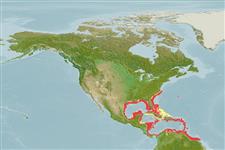Environment: milieu / climate zone / depth range / distribution range
Ecology
Marine; brackish; reef-associated; depth range 27 - 95 m (Ref. 7251). Tropical; - 6°N
Western Atlantic: northeastern Florida (USA), Gulf of Mexico, and the Antilles to Guyana.
Length at first maturity / Size / Weight / Age
Maturity: Lm 9.6, range 6 - ? cm
Max length : 20.0 cm TL male/unsexed; (Ref. 7251); common length : 15.0 cm TL male/unsexed; (Ref. 5217)
Found between the shore and 100 m depth, on sand or mud bottoms rich in organic matter. Feed mainly on shrimps (Penaeidae), amphipods, crustacean larvae and annelids. The whole life cycle develops on the continental shelf. During reproduction in May and September, adults gather in shallow waters of the estuaries and along the coast. Sexual activity takes place during the rainy season which corresponds to quite a large influx of organic matter, thereby ensuring food for the breeding fish. Sexual dimorphism affects the interorbital width and pectoral fin length of the hidden side. Juveniles remain planktonic for a long time with a high growth rate of >5% per day (Ref. 35237).
Life cycle and mating behavior
Maturities | Reproduction | Spawnings | Egg(s) | Fecundities | Larvae
Distinct pairing (Ref. 205).
Robins, C.R. and G.C. Ray, 1986. A field guide to Atlantic coast fishes of North America. Houghton Mifflin Company, Boston, U.S.A. 354 p. (Ref. 7251)
IUCN Red List Status (Ref. 130435)
Threat to humans
Harmless
Human uses
Fisheries: minor commercial
Tools
Special reports
Download XML
Internet sources
Estimates based on models
Preferred temperature (Ref.
123201): 21.2 - 27.4, mean 24.8 °C (based on 104 cells).
Phylogenetic diversity index (Ref.
82804): PD
50 = 0.5039 [Uniqueness, from 0.5 = low to 2.0 = high].
Bayesian length-weight: a=0.00724 (0.00394 - 0.01332), b=3.09 (2.93 - 3.25), in cm total length, based on LWR estimates for this species & Genus-body shape (Ref.
93245).
Trophic level (Ref.
69278): 3.3 ±0.44 se; based on food items.
Generation time: 1.6 ( na - na) years. Estimated as median ln(3)/K based on 1
growth studies.
Resilience (Ref.
120179): High, minimum population doubling time less than 15 months (Preliminary K or Fecundity.).
Fishing Vulnerability (Ref.
59153): Low vulnerability (10 of 100).
Nutrients (Ref.
124155): Calcium = 80.6 [31.0, 168.8] mg/100g; Iron = 0.655 [0.300, 1.155] mg/100g; Protein = 17.2 [15.1, 19.5] %; Omega3 = 0.098 [0.050, 0.191] g/100g; Selenium = 35.4 [17.1, 76.4] μg/100g; VitaminA = 53.4 [12.4, 241.2] μg/100g; Zinc = 1.39 [0.90, 2.04] mg/100g (wet weight); based on
nutrient studies.
